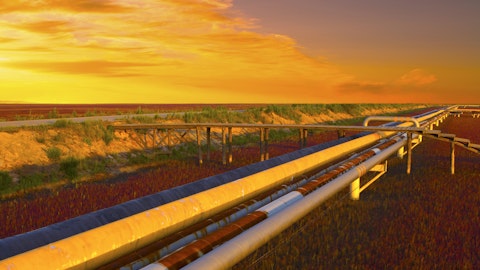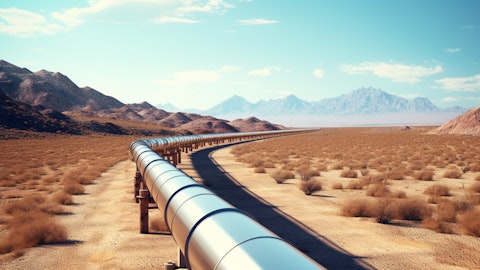Jamie Welch: Yeah John it’s interesting that the whole concept behind Infinium was predicated on the conversion of what was a traditional suite system, which was the old BCP, EagleClaw, Caprock to a system that could take sour gas. We are seeing greater levels of sour gas. We, therefore, see much more CO2 tonnage created and Tyler working with Infinium said with all the CO2 tonnage, this is a stream that we can give you by pipe and they can then obviously using their process they can convert it into eFuels. No capital, no OpEx for us. It’s fully paid for. We got a really nice return. So, we’re getting paid on the treating side by our customers. And with the byproduct that we’re creating, which is incremental direct CO2, we are getting paid for the CO2 stream.
John Mackay: That’s great. That makes sense. And you kind of touched on my next question. You touched on it a little bit earlier on the call too. But maybe you can kind of just frame up the size of this sour gas opportunity overall. I mean it feels pretty large. It feels like there’s some producers pushing in there and maybe some of your midstream peers aren’t necessarily keeping up. So, just wondering if you could kind of frame up that broader opportunity on both gathering processing treating side et cetera?
Jamie Welch: We’ll let Mr. Kindrick take the floor.
Kris Kindrick: Hey John this is Kris. Look it’s a great question. And as we’ve alluded to earlier as we continue to go north in the basin and as our customers drill shallower formations we see a higher amount of CO2 and some higher amount of nitrogen. So one of our goals has been once our trading is installed is to add additional fees and treat that gas. One other point I’d like to make too is we have some incremental treating capacities down at Diamond. So, Matt and the operations team is looking at ways to optimize our system to be able to add more CO2 to the system, so we can extract fees there. So, I think the opportunity is great. I think the oil cuts are great from these benches. So, the customers want a solution to be able to treat not only the CO2, but handle the nitrogen. So, we try to get in front of that and are currently talking to a number of producers about a solution there.
Jamie Welch: And it’s also true I think Kris that on the shallower formations to Avalon and Bone Spring, we see less water — produced water.
Kris Kindrick: That’s right.
Jamie Welch: So, I do think there is an element on this which is the produced water and the gathering and disposal of that is an element, significant costs from the producer side. Not having to deal with as much water is obviously a huge net benefit for them. So, I do think that goes into the overall equation of the decision-making process for our producers and where they’re focusing. And so therefore our ability to take wider ranges of CO2 high levels of H2S and even nitrogen and blamed it and treated is a massive competitive advantage for us in the context of what our customers are now focusing on.
John Mackay: Super. Thanks for that.
Operator: Thank you. The next question comes from the line of Neel Mitra with Bank of America. Your line is now open.
Neel Mitra: Hi. Thanks for taking my question. Jamie just wanted to kind of touch on the cadence of rich gas growth going through April and May. It seems like that’s been strong, but I was wondering with the gas takeaway situation right now, if there’s been any producer issues with getting the gas out of the basin? I know there’s been a lot of ethane recovery and maybe moving to markets that are less than desirable. But just trying to understand the flow trends there?
Jamie Welch: Yes. And Neel thank you. Good morning. I think as we mentioned both in our prepared remarks and maybe an answer to another question, the oil-directed drilling cadence has not changed at all. If anything, we’ve seen it really continue to pick up which is somewhat typical. Second quarter through third quarter is literally I want to say prime time as far as turn-in-line activity is concerned that’s when it all happens because you sort of — you’re out of the pockets of the year where you have the potential for some challenging climate and weather. But I think what’s interesting for us — and again this comes back to I would say almost the switchboard that Kindred’s got as far as the number of customers calling everybody knows that we’ve got space on PHP.
They are literally banging down his door saying can I, can I, will we, will you, take my gas, I have gas here, I need help. And look we are very customer-focused and we’re very customer-centric. And our viewpoint is we’ve got space that we can basically fit in packages of gas. We can give people a hand. We want to see more activity. And so we look at our role as being a partner with our customers in the context of helping them achieve their ultimate goals. Kris, would you add anything?
Kris Kindrick: No Jamie, I think that’s right. I think Jamie alluded to this earlier Neel that, having the PHP space is one big differentiator for us and it has allowed us to provide egress takeaway not see the curtailments, and unlike maybe some of our peers that don’t have access to the Gulf Coast. So, it’s been a great tool to have, and we’re going to continue to use it to help grow our business.
Neel Mitra: Got it. And then, second question. Now the Apache exited the position and you have a bigger public float, you’re still a capital constraint in the sense that you want to get to investment grade, and it looks like you’re on the path there and you expanded into other parts of the Permian and the New Mexico area. How are you looking at M&A now in terms of maybe like a bolt-on gathering system, given that you’ve been able to integrate your upstream and your downstream position like with PHP and other downstream solutions for those customers? And how would that work in terms of maintaining your leverage ratios and also increasing the public float. Is that something that you are considering or have on as an option?


